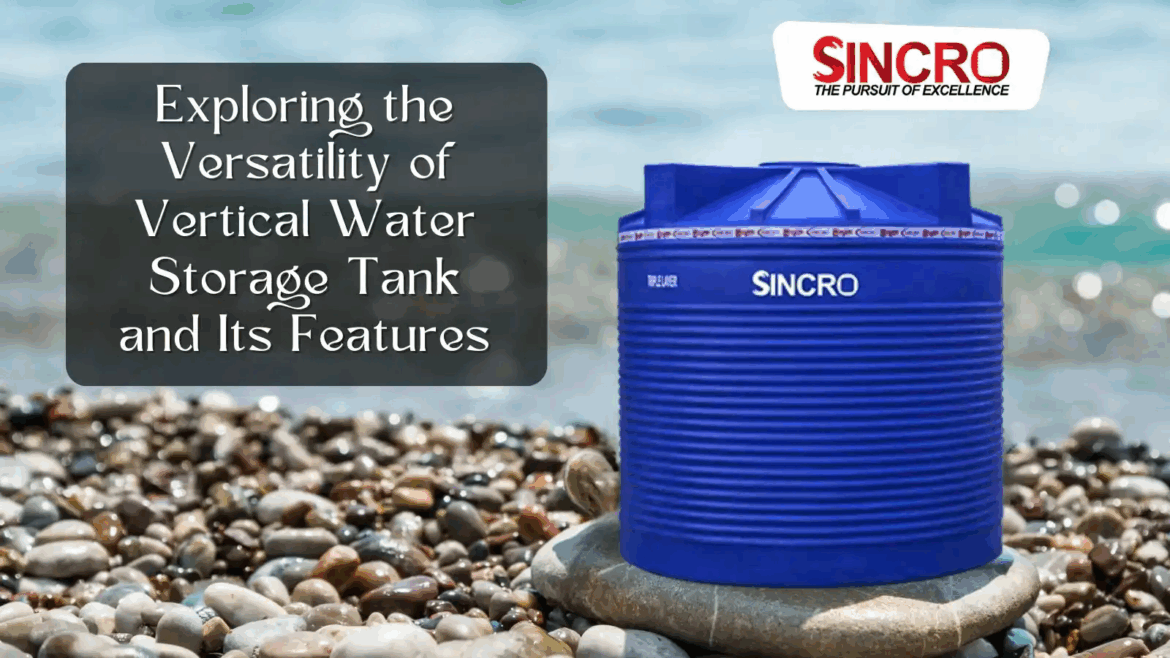Water scarcity, intermittent supply, and space limitation are some of the common problems that can be observed in Mumbai and in many other metro locations in India. In such situations, vertical water tanks make an intelligent, practical, and space-efficient choice.
This blog relates to the versatility of vertical water storage tanks, features, benefits, etc., and why it has become popular, especially in Mumbai.
Types of Vertical Water Storage Tanks
There are a variety of vertical tank types to meet individual needs:
- Cylindrical (round) vertical tanks — Most common, well balanced to resist stress.
- Vertical rectangular water tanks — These types of tanks can be useful when design and structural constraints dictate a squarer profile, and/or stacking against walls or corners.
- Multi-layer vertical tanks (double, triple, or more layers) — These provide insulation, UV protection, and extra strength.
- Vertical triple layer water tank — A specialty product that combines durability, UV protection, and better quality water retention.
Explore a more detailed typology of vertical options here and other types of water storage tanks.
Each of these types presents some aspects of pros and cons depending on capacity, location (roof, terrace, or ground), and climate exposure or structural limitations.
Key Features & Advantages of Vertical Tanks
What distinguishes vertical water storage tanks? Several notable benefits:
- Space Efficient – Vertical storage allows for a smaller footprint and more options within a limited horizontal area.
- Better Water Pressure – Height is an advantage, as vertical height contributes to the gravitational pressure versus relying on pumps. Vertical water storage is advantageous in any building, particularly in lower buildings.
- Better Settling of Sediment – The cylindrical/tall structure allows sediment to settle toward the bottom and has an upper layer of cleaning water for a longer duration.
- Durability and Weather Resistance – Quality vertical tanks are made from food-grade, UV-stabilized plastic that is resistant to cracking as well as algae retention and degradation when exposed to the elements (such as in Mumbai!).
- Cost Efficiency – Less site footprint, easier installation, and maintenance contribute to vertical tanks being more economical in many situations.
- Versatile Use – Vertical tanks are associated with uses in residential buildings and industrial applications; they are particularly suited for compressed areas such as rooftops, terraces, and other tighter spaces.
- Insulation & Multi-Layer Engineering- Tanks with multiple layers (double/triple/quad) help maintain water temperature and protect from sunlight effects.
Find out the advantages of vertical tanks in detail
Why Choose a Vertical Plastic Water Tank (Over Other Alternatives)?
When comparing tank systems, vertical plastic water tanks are a more robust option than steel or concrete tanks. The benefits of plastic tanks, in addition to being lighter and easier to install, are, they are also corrosion resistant. This corrosion resistance is important, especially in coastal areas like Mumbai.

Plastic tanks can also be rotationally molded into a single seamless piece of plastic and, therefore, have no issues of leaks at joints. Their smooth inner surface also helps reduce bacterial growth and algae accumulation.
Reasons Why Vertical Water Tanks are Gaining Popularity in Mumbai
With its density and high-rise buildings, Mumbai’s living and working profiles lend themselves perfectly to vertical water tanks in Mumbai. Horizontal (or ground) tanks usually require more footprint area, which is hard to find in busy urban areas. Vertical water tanks require a smaller footprint, as their design is progressively stacked so that water can be stored efficiently in a small base area. Vertical water storage tanks are ideal for apartments, commercial buildings, and housing societies in Mumbai.
If you are looking for high-quality locally supplied vertical tanks, consider Sincro as a recognized brand for vertical plastic water tanks.
Conclusion
Vertical tanks are extremely versatile, efficient, and practical– so if you have minimal access to space, such as in a city like Mumbai. Their height-driven pressure, compact footprint, sediment management, and durable materials make them an excellent choice for households, commercial buildings, and industrial setups alike.
If you are in search of a professional supplier of vertical water tanks in Mumbai, or would like assistance deciding on the size tank that is best for your needs (vertical plastic, rectangular, triple-layered, etc), you should check Sincro.
FAQ
Q1. What is a vertical water storage tank?
A vertical water storage tank is a vertical, designed container (tall, cylindrical, or rectangular) for the storage of water, as it takes up as little ground space as possible. The vertical aspect saves space and allows for more storage capacity in a reduced footprint area, which makes them ideal for urban spaces like Mumbai.
Q2. Why should I choose a vertical water tank over a horizontal one?
Vertical tanks take up a smaller footprint and provide better water pressure. Sediment will accumulate at the bottom of the tank and won’t mix with the clean water at the top of the tank. Vertical tanks are great for rooftops, balconies, and tighter spaces for urban applications.
Q3. Are vertical plastic water tanks durable?
Yes. Good quality vertical water tanks are constructed from a food-grade polyethene that is UV-stabilized to help reduce cracking, corrosion, and algae growth for many years, especially in harsher conditions.
Q4. What sizes are available for vertical water storage tanks?
Vertical water tanks can be achieved in a range of sizes, with small household tanks of approximately 200 liters to large tanks over 10,000 liters for industrial use, so you are able to choose the appropriate size for your site and water requirements.
Q5. Where can I buy vertical water tanks in Mumbai?
Quality vertical storage water tanks can be had in Mumbai directly from Sincro. They are a reliable manufacturer with a full offering of vertical tanks in a variety of shapes, including plastic, rectangular, and triple-layered.







